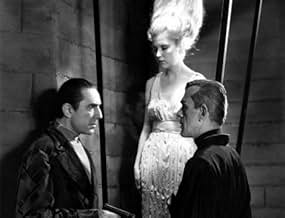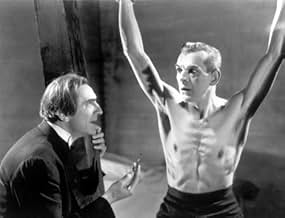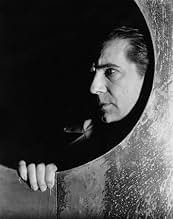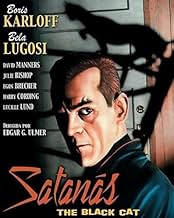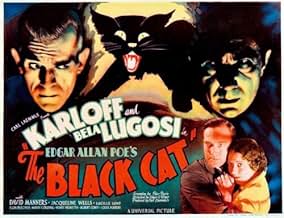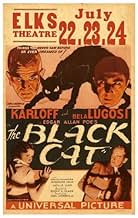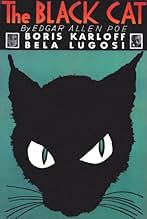Ein amerikanisches Paar auf Hochzeitsreise in Ungarn wird im Haus eines satanistischen Priesters gefangengenommen, als die Braut nach einem Autounfall dort medizinisch versorgt werden soll.Ein amerikanisches Paar auf Hochzeitsreise in Ungarn wird im Haus eines satanistischen Priesters gefangengenommen, als die Braut nach einem Autounfall dort medizinisch versorgt werden soll.Ein amerikanisches Paar auf Hochzeitsreise in Ungarn wird im Haus eines satanistischen Priesters gefangengenommen, als die Braut nach einem Autounfall dort medizinisch versorgt werden soll.
- Auszeichnungen
- 2 Gewinne & 1 Nominierung insgesamt
Boris Karloff
- Hjalmar Poelzig
- (as Karloff)
Julie Bishop
- Joan Alison
- (as Jacqueline Wells)
Virginia Ainsworth
- Cultist
- (Nicht genannt)
Luis Alberni
- Train Steward
- (Nicht genannt)
King Baggot
- Cultist
- (Nicht genannt)
Herman Bing
- Car Steward
- (Nicht genannt)
Symona Boniface
- Cultist
- (Nicht genannt)
John Carradine
- Cult Organist
- (Nicht genannt)
André Cheron
- Train Conductor
- (Nicht genannt)
George Davis
- Bus driver
- (Nicht genannt)
Andy Devine
- Bit Part
- (Nicht genannt)
Empfohlene Bewertungen
I can't imaging how this movie would have been without both Bela Lugosi and Boris Karloff, probably very very bad. The chemistry between the two is amazing.
This is one of those movies in which the story absolutely doesn't matter. The story is totally absurd and very simple (The black cat storyline has absolutely nothing to do with the movie and serves no purpose at all) but yet that is what maybe makes this movie extremely fun and easy to watch.
Watching this movie made me realize something; Bela Lugosi actually was a very good actor that was ahead of his time. The way he delivers his lines and his eye for details shows that acting was a great passion for him. Yes I think I can now be considered one of his fans.
Another great thing were the sets that were wonderful and even now 70 years later they still look very modern.
Don't expect a movie with ghouls and monsters, it rather is more fun to watch then it is scary and the Lugosi/Karloff combination is what makes this movie a real classic.
7/10
http://bobafett1138.blogspot.com/
This is one of those movies in which the story absolutely doesn't matter. The story is totally absurd and very simple (The black cat storyline has absolutely nothing to do with the movie and serves no purpose at all) but yet that is what maybe makes this movie extremely fun and easy to watch.
Watching this movie made me realize something; Bela Lugosi actually was a very good actor that was ahead of his time. The way he delivers his lines and his eye for details shows that acting was a great passion for him. Yes I think I can now be considered one of his fans.
Another great thing were the sets that were wonderful and even now 70 years later they still look very modern.
Don't expect a movie with ghouls and monsters, it rather is more fun to watch then it is scary and the Lugosi/Karloff combination is what makes this movie a real classic.
7/10
http://bobafett1138.blogspot.com/
This early horror film concerns Dr. Vitus (Bela Lugosi) and a couple having an accident . They find shelter into the impressive mansion of architect Poelzig (Boris Karloff) . He built it over the corpses of thousands of dead people in a horrible war whose commander was Poelzig . Karloff followed his success in Frankenstein movie with the title role in this low budget terror classic about the leader of a band of devil-worshippers who wants to steal a gorgeous young woman (Jacqueline Welles : Julie Bishop) from her new husband (David Manners of The mummy).
The movie provides genuine chills , suspense , mystery and is rich and dark , although ludicrous at times . It's an exciting ,bizarre film skillfully paced by Edgar G. Ulmer and results to be one of the most unusual horror film ever made and certainly one of the most unsettling. Suggested by the immortal Edgar Allan Poe novel of the same title which was filmed like as one episode ¨The Black Cat¨ into the ¨Tales of terror¨ by Roger Corman and with Vincent Price and Peter Lorre , however here bears absolutely no resemblance . This gem features sets and production design with standards usually found in movies made by the major studios . The rousing mansion , lounges , rooms get an art nouveau and modernism style , besides the satanic mass is developed in a surrealistic scenario. Art director achieves some remarkable tableaux that could be removed from the movie and hung in art galleries alongside the work of famous painters . A minor classic with outstanding performances from Karloff and Lugosi in their first of many pairing. The picture is today deservedly considered a cult favorite thanks the distinguished teaming.
The movie provides genuine chills , suspense , mystery and is rich and dark , although ludicrous at times . It's an exciting ,bizarre film skillfully paced by Edgar G. Ulmer and results to be one of the most unusual horror film ever made and certainly one of the most unsettling. Suggested by the immortal Edgar Allan Poe novel of the same title which was filmed like as one episode ¨The Black Cat¨ into the ¨Tales of terror¨ by Roger Corman and with Vincent Price and Peter Lorre , however here bears absolutely no resemblance . This gem features sets and production design with standards usually found in movies made by the major studios . The rousing mansion , lounges , rooms get an art nouveau and modernism style , besides the satanic mass is developed in a surrealistic scenario. Art director achieves some remarkable tableaux that could be removed from the movie and hung in art galleries alongside the work of famous painters . A minor classic with outstanding performances from Karloff and Lugosi in their first of many pairing. The picture is today deservedly considered a cult favorite thanks the distinguished teaming.
There's a lot of story to tell in about 65 minutes, so this movie could be considered perhaps a bit incoherent. But the larger themes -- revenge, lust and innocents caught in the grip of forces beyond their sheltered experience -- have been central themes in horror tales for centuries.
Karloff is a delight as usual, and there are many fine details to his performance -- including a brief but outrageously lustful stare at the half-dressed young wife of the innocent couple and the strangely gentle way his brutal character handles a cat. (Nice tall, dark and handsome kitty in the title role, for the cat people.)
And this movie also shows once again that Bela Lugosi was a better actor than he ever got credit for. He handles his overwrought dialogue with taste and good cheer, and he's a marvel. And he even gets to speak a few rare lines of Hungarian here.
Karloff is a delight as usual, and there are many fine details to his performance -- including a brief but outrageously lustful stare at the half-dressed young wife of the innocent couple and the strangely gentle way his brutal character handles a cat. (Nice tall, dark and handsome kitty in the title role, for the cat people.)
And this movie also shows once again that Bela Lugosi was a better actor than he ever got credit for. He handles his overwrought dialogue with taste and good cheer, and he's a marvel. And he even gets to speak a few rare lines of Hungarian here.
I won't comment about the acting or plot -- there's plenty of that here already. What I'd rather do is call attention to the visuals -- the cinematography, lighting, costuming, and especially the set design.
Normally, horror films take place in ancient settings -- crude medieval fortresses and rustic castles that are dark, cluttered and gloomy. But this one is set in a perversely utopian sci-fi fantasy -- the clean lined, impeccably detailed, generously glazed modernistic and (usually) radiantly lit white-and-silver upper floor interiors of the house.
The lower floor is an expressionistic prison, also clean lined, but still dungeon-like with its windowless walls of exposed board-formed concrete. An elegant steel spiral staircase connects the two, and the angular expressionism reaches its culmination in the chamber used for the black mass.
Karloff's costumes recall Oskar Schemmer's Bauhaus-produced work -- angular, broad-shouldered, narrow-waisted and elegant. Even the haircut of this man of the future in sharp and angular. His character is an engineer and architect and is given the name -- Poelzig -- of a famous expressionist German architect and film set designer of the time, who was a colleague of the director on an earlier film. The elegant futurism in carried down to the detail level, including a digital night-table clock and an abstract chess set. Much of the genius of this movie is that it breaks the horror-movie visual mold, and floods it with light, creating a fascinating tension between plot and setting.
Normally, horror films take place in ancient settings -- crude medieval fortresses and rustic castles that are dark, cluttered and gloomy. But this one is set in a perversely utopian sci-fi fantasy -- the clean lined, impeccably detailed, generously glazed modernistic and (usually) radiantly lit white-and-silver upper floor interiors of the house.
The lower floor is an expressionistic prison, also clean lined, but still dungeon-like with its windowless walls of exposed board-formed concrete. An elegant steel spiral staircase connects the two, and the angular expressionism reaches its culmination in the chamber used for the black mass.
Karloff's costumes recall Oskar Schemmer's Bauhaus-produced work -- angular, broad-shouldered, narrow-waisted and elegant. Even the haircut of this man of the future in sharp and angular. His character is an engineer and architect and is given the name -- Poelzig -- of a famous expressionist German architect and film set designer of the time, who was a colleague of the director on an earlier film. The elegant futurism in carried down to the detail level, including a digital night-table clock and an abstract chess set. Much of the genius of this movie is that it breaks the horror-movie visual mold, and floods it with light, creating a fascinating tension between plot and setting.
"The Black Cat" (Universal, 1934), directed by Edgar G. Ulmer, marks the first scream, or should I say, screen teaming of Boris ("Frankenstein") Karloff, billed in the credits only as KARLOFF, and Bela ("Dracula") Lugosi.
Suggested on the immortal story by Edgar Allan Poe, the plot, compliments of screenwriter Paul Ruric, set in Hungary, gets right down to business with Doctor Vitus Werdegast (Bela Lugosi) returning home by train after serving 15 long years in a military prison. He finds himself sharing a compartment with mystery writer Peter Allison (David Manners) and his wife, Joan (Jacqueline Wells), on their honeymoon. Vitus introduces himself to the Allisons, talks about himself and of his mission to visit a "very old friend." The couple later accompany Werdegast on a bus to their destination, which meets with an accident during a rainstorm, killing the driver. Vitus accompanies Peter by taking the injured Joan through the rain and winds until they reach the home of Hjalmar Poelzig (KARLOFF), an architect of his futuristic mansion. As Vitus treats the unconscious Joan, Hjalmar, who makes his grand entrance, immediately takes notice on the young girl with intentions that are not too honorable. As the story progresses, the viewer learns that Vitus had been betrayed by Hjalmar during the World War and left to die at a military prison, and for this, Vitus, who survived those long dark years, returns to seek revenge, but first must learn what has happened to his wife and daughter. Peter and Joan become house guests in the home of Poelzig, unaware that they are his prisoners, with Poelzig, who holds Black Masses in a devil's cult ceremony, intending on using Joan as his next subject and hold Peter in a dungeon below. Besides trying to learn the whereabouts of his wife and daughter, Vitus tries to set Joan free by playing a game of chess, or a "game of death," with Hjalmar. Tension builds up to a very suspenseful climax not to be missed.
What does this have to do with a black cat? Well, Vitus fears cats and finds himself being confronted with one in two separate scenes, compliments of Hjalmar, who has cats roaming about. Karloff and Lugosi are evenly matched here, and as bitter enemies, they must present themselves in a "gentlemanly manner" whenever confronted by the young guest or guests. Also presented in the cast are Lucille Lund as Karen Poelzig; the evil looking Harry Cording as Thalmar, Hjalmar's servant; and John Carradine as one of the members of the cult during the Black Mass sequence.
Although produced in Hollywood, "The Black Cat" looks very much like a European production with futuristic sets which features a digital clock, etc. Karloff, dressed in black garments with a feline haircut, is very creepy, especially using gestures with his evil eyes (which do everything but glow in the dark!); Lugosi, in a rare sympathetic role, is actually the stronger character, giving one of his best performances in his career, next to "Dracula" (1931). Fortunately, "The Black Cat" was released shortly before the Production Code took effect, otherwise the horror drama, with many scenes quite questionable then and now, would never have reached the theaters unless severely edited to a point of confusion. Chances are the movie itself was edited prior to release, but at 66 minutes, it's tight and fast-paced, never a dull moment. A big plus in this production is the underscoring montage of classical compositions by various composers, lavish sets and the teaming of two horror greats, Karloff and Lugosi.
Aside from Fright Nights on commercial television back in the 1960s and 70s, "The Black Cat" formerly played on the Sci-Fi Channel in the 1990s, and later on American Movie Classics from 2000 to 2001. To date, "The Black Cat" can be seen on Turner Classic Movies where it premiered on January 24, 2003, becoming one of this cable channel's most revived horror films. Probably by request. "The Black Cat" is also available on video cassette either as part of the double feature along with "The Raven" (1935), another Karloff and Lugosi thriller, or as a solo package. A gem for fans of this genre. (***)
Suggested on the immortal story by Edgar Allan Poe, the plot, compliments of screenwriter Paul Ruric, set in Hungary, gets right down to business with Doctor Vitus Werdegast (Bela Lugosi) returning home by train after serving 15 long years in a military prison. He finds himself sharing a compartment with mystery writer Peter Allison (David Manners) and his wife, Joan (Jacqueline Wells), on their honeymoon. Vitus introduces himself to the Allisons, talks about himself and of his mission to visit a "very old friend." The couple later accompany Werdegast on a bus to their destination, which meets with an accident during a rainstorm, killing the driver. Vitus accompanies Peter by taking the injured Joan through the rain and winds until they reach the home of Hjalmar Poelzig (KARLOFF), an architect of his futuristic mansion. As Vitus treats the unconscious Joan, Hjalmar, who makes his grand entrance, immediately takes notice on the young girl with intentions that are not too honorable. As the story progresses, the viewer learns that Vitus had been betrayed by Hjalmar during the World War and left to die at a military prison, and for this, Vitus, who survived those long dark years, returns to seek revenge, but first must learn what has happened to his wife and daughter. Peter and Joan become house guests in the home of Poelzig, unaware that they are his prisoners, with Poelzig, who holds Black Masses in a devil's cult ceremony, intending on using Joan as his next subject and hold Peter in a dungeon below. Besides trying to learn the whereabouts of his wife and daughter, Vitus tries to set Joan free by playing a game of chess, or a "game of death," with Hjalmar. Tension builds up to a very suspenseful climax not to be missed.
What does this have to do with a black cat? Well, Vitus fears cats and finds himself being confronted with one in two separate scenes, compliments of Hjalmar, who has cats roaming about. Karloff and Lugosi are evenly matched here, and as bitter enemies, they must present themselves in a "gentlemanly manner" whenever confronted by the young guest or guests. Also presented in the cast are Lucille Lund as Karen Poelzig; the evil looking Harry Cording as Thalmar, Hjalmar's servant; and John Carradine as one of the members of the cult during the Black Mass sequence.
Although produced in Hollywood, "The Black Cat" looks very much like a European production with futuristic sets which features a digital clock, etc. Karloff, dressed in black garments with a feline haircut, is very creepy, especially using gestures with his evil eyes (which do everything but glow in the dark!); Lugosi, in a rare sympathetic role, is actually the stronger character, giving one of his best performances in his career, next to "Dracula" (1931). Fortunately, "The Black Cat" was released shortly before the Production Code took effect, otherwise the horror drama, with many scenes quite questionable then and now, would never have reached the theaters unless severely edited to a point of confusion. Chances are the movie itself was edited prior to release, but at 66 minutes, it's tight and fast-paced, never a dull moment. A big plus in this production is the underscoring montage of classical compositions by various composers, lavish sets and the teaming of two horror greats, Karloff and Lugosi.
Aside from Fright Nights on commercial television back in the 1960s and 70s, "The Black Cat" formerly played on the Sci-Fi Channel in the 1990s, and later on American Movie Classics from 2000 to 2001. To date, "The Black Cat" can be seen on Turner Classic Movies where it premiered on January 24, 2003, becoming one of this cable channel's most revived horror films. Probably by request. "The Black Cat" is also available on video cassette either as part of the double feature along with "The Raven" (1935), another Karloff and Lugosi thriller, or as a solo package. A gem for fans of this genre. (***)
Wusstest du schon
- WissenswertesAmong the unconventional elements of this film was the soundtrack. At a time (early 1930s) when movie music was usually limited to the titles and credits, Edgar G. Ulmer had an almost continuous background score throughout the entire film.
- PatzerVitus identifies Kurgaal as being "near Omsk, by Lake Baikal." In reality Omsk and Lake Baikal are approximately 1000 miles apart and are nowhere near each other.
- Zitate
Hjalmar Poelzig: Did you hear that, Vitus? The phone is dead. Even the phone is dead.
- VerbindungenEdited from Rom Express (1932)
Top-Auswahl
Melde dich zum Bewerten an und greife auf die Watchlist für personalisierte Empfehlungen zu.
Details
- Erscheinungsdatum
- Herkunftsland
- Sprachen
- Auch bekannt als
- El gato negro
- Drehorte
- Produktionsfirma
- Weitere beteiligte Unternehmen bei IMDbPro anzeigen
Box Office
- Budget
- 95.745 $ (geschätzt)
- Weltweiter Bruttoertrag
- 180 $
- Laufzeit1 Stunde 5 Minuten
- Farbe
- Seitenverhältnis
- 1.37 : 1
Zu dieser Seite beitragen
Bearbeitung vorschlagen oder fehlenden Inhalt hinzufügen


